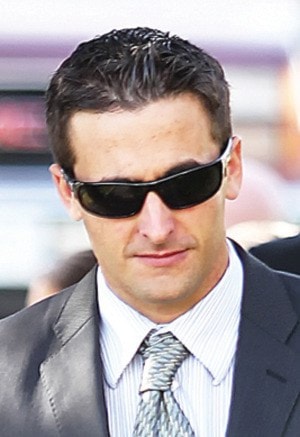Fear-induced stress, not self defence, was a key in RCMP Const. David Pompeo’s shooting of Bill Gillespie near Chemainus on Sept. 18, 2009, Judge Josiah Wood explains in his reasons for finding Pompeo guilty Thursday of aggravated assault.
Duncan court judge Wood issued his 83-page reasons for judgement Friday.
The extent to which Pompeo’s perceptions that dark night in a driveway were “distorted by fear-induced stress is also evident from the fact (Pompeo) was oblivious to what transpired between Gillespie and Const. (David) Birchett (Pompeo’s police partner).”
At issue during testimony, was Pompeo’s belief he shot in self defence as he thought Gillespie, who was later deemed unarmed, was about to pull a gun from his pocket.
That belief sparked fear in Pompeo whose pistol, and that of Birchett, were drawn when Gillespie, and passenger Dale Brewer, were stopped and got out of their Saturn sedan.
Had Pompeo realized what was unfolding, and recognized Gillespie eventually followed Birchett’s order to get on the ground, “Const. Pompeo’s threat assessment ought to have moderated to the point where he would at least have been able to wait to see if Gillespie’s left hand actually went into his pocket before (Pompeo) decided to pull the trigger,” Wood writes.
But Judge Wood explains Pompeo’s ability to accurately perceive an actual threat by Gillespie — namely Pompeo’s concern Gillespie was reaching for a gun when stepping from the Saturn — was affected, prompting Pompeo’s “inability to see anything other than threat cues from that point on — and the extent to which his growing fear provoked a stress that adversely affected both his vision, and his ability to hear.”
The North Cowichan/Duncan detachment officers basically faced the same situation when handling Gillespie and Brewer, Wood explains.
Both officers immediately escalated through to the final Incident Management-Intervention Model (danger) response option by drawing their firearms almost immediately when leaving their pickup truck, explains Wood.
“The final decision for both was the same; namely whether to fire their weapon.
“Pompeo had in excess of 30 seconds in which to reach that decision,” Wood explain.
That half-minute, Wood explains, saw Gillespie do little except twice put his left hand into his left jacket pocket “from which it emerged on each occasion without a weapon.”
Summarizing, Judge Wood found failure by Pompeo to follow his use-of-force training; that his experience with armed suspects had little relevance to the night’s circumstances, except use of caution; and that Pompeo failed and/or lost the ability to accurately perceive critical aspects of the events unfolding.
Despite the fast pace, explains Wood, Pompeo had enough time to make an accurate threat assessment.
And Pompeo had no background knowledge Gillespie had a conviction for a violent offence, such as robbery associated with a firearm, Wood notes.
Still, Pompeo “had a grossly exaggerated perception” of long and how far Gillespie — who seemed threatening and unable follow commands to hit the ground — advanced toward Pompeo, says Wood, noting both cops faced the same possible threat.
Birchett testified Brewer was also non-compliant and threatening, but he gave Brewer more time to follow several orders to get on the ground.
Ultimately, Judge Wood rules it’s critical police officers maintain sufficient composure to accurately assess threats, and must use the utmost care in judgement before deciding to use lethal force.
Wood dismisses Pompeo’s belief he was about to be attacked by Gillespie — who still carries Pompeo’s 9-mm slug in his upper body.
“I am satisfied the Crown has established, beyond a reasonable doubt (Pompeo’s) belief he was facing death, or grievous bodily harm, was not based on reasonable grounds,” he concludes.
March 12 is when a date is to be fixed for Pompeo’s sentencing.
